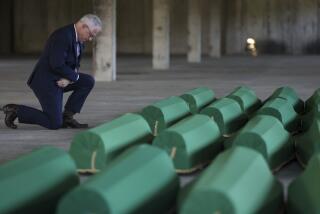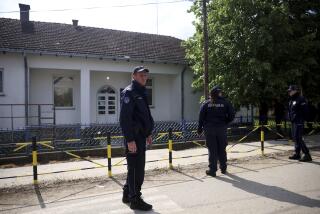Yugoslavia Limps Toward ‘92, Oblivion
- Share via
BARANJA, Serbian-occupied Croatia — The Serbian guerrilla parked his cigarette between cracked lips while he fished in a pocket for evidence he’d taken from the corpse of a Croat a few days earlier.
He slapped four rifle cartridges onto the wooden bar table, rattling empty bottles and ashtrays strewn among puddles of spilled liquor.
“These are hollow-point bullets, designed to rip through a man’s flesh!” hissed the fighter, Nikola, his eyes blazing in anger. “The Ustasha (Croats) will stop at nothing to inflict suffering on Serbs.”
Only a few miles away, on the other side of the battle lines in this Serbian-occupied corner of Croatia, a rancher hunkered with his shotgun and three adult sons in the basement of his house in Vinkovci. The dwelling above them had been reduced to rubble by shellfire from fighters like Nikola and federal troops of the Yugoslav army.
“We can last for five years this way!” vowed the 52-year-old Croatian holdout, Stanko, whose basement is stocked with cases of smoked meat and vats filled with rainwater. “The Chetniks (Serbs) who began this war will have to kill us all before we will give up on the goal of freedom.”
As 1991 and the history of Yugoslavia draw to a turbulent close, Serbs and Croats sharpened their hatred and seemed only to have begun their bloody and unwinnable fight.
Serbian President Slobodan Milosevic has convinced the 10 million Serbs who live scattered among Yugoslavia’s six republics that they face annihilation unless they can live in a united Yugoslavia or an independent Serbian state.
Mindful of the atrocities committed by Croatia’s Ustasha regime during World War II, ethnic Serbs who make up 12% of Croatia’s population refuse to be severed by secession from their brothers in Serbia.
Croatian President Franjo Tudjman, nationalist leader of Yugoslavia’s 5 million Croats, has instilled in his people a profound belief that they can survive only through the independence that rival Serbia so vehemently opposes.
Angered by Serbian and federal army attempts to keep them forcefully bound within Yugoslavia, Croats are fiercely fighting off attacks by “Chetniks”--a reference to the pro-monarchist Serbian irregulars who fought Croats and Communists in the last war. They accuse today’s Serbian fighters of seeking revenge and new territory for Serbia.
Unable or unwilling to compromise, the two nations have plunged headlong into war and exposed the European Continent to its worst violence since World War II.
In a scant six months since Slovenia and Croatia declared independence, the war has claimed about 10,000 lives, driven half a million Yugoslavs from their homes, spotlighted the limits of diplomacy and made a mockery of the new world order.
No closer to unity and peaceful coexistence than when their federation was created in 1918, the fractious people of the Balkans bid a bitter good riddance to Yugoslavia, seemingly trying to prove that its tortured, 73-year life had been for naught.
The combatants, far from deterred by a tragedy of their own making, have become locked in a self-perpetuating cycle of violence that inflicts suffering and stirs desire for revenge.
“At least five years, probably 10 or 20,” Nikola predicted when asked how long the war would last.
“Maybe forever,” Stanko replied to the same question. “The war will go on as long as it takes to free Croatia.”
The conflict in Yugoslavia is a study in the dangers of nationalism let loose in volatile societies emerging from repression and isolation.
Serb-Croat animosity harks back centuries, embracing the historic rivalry between Eastern Orthodoxy and Catholic Europe. The religious and cultural divide still severs the Balkan Peninsula, roughly along the battle line of today’s war. Serbia was ruled for 500 years by Ottoman Turkey, while Croatia and Slovenia were part of the Austro-Hungarian Empire.
Yugoslavia was formed from states that had only geography in common. Ethnic intrigues, assassinations and dictatorship marked the first decades of “unity,” collapsing into civil war by the time of the Nazi invasion in 1941.
Communist dictatorship was all that kept ethnic tensions in check after World War II, and when Marshal Tito died in 1980, the federation began unraveling.
Milosevic rose to power in Serbia in 1987 by employing the Communist tools of propaganda and brute force. Fellow Serbs swallowed his warnings about threats from Albanians, Croats and Muslims, uniting behind the ardent nationalist in a campaign to protect themselves by ensuring Serbian domination of the federation.
When multi-party elections were held in Slovenia and Croatia in early 1990, both republics backed secessionist platforms.
The tempo of Yugoslavia’s death dance stepped up with the start of this year, spinning faster and more furiously as 1991 careened toward its blood-spattered end.
Successive attempts to negotiate a controlled breakup failed as Serbia rejected any looser realignment, prompting the Western republics to declare independence on June 25, setting off the conflict that rages today.
The federal army’s involvement has inflated what might have remained scattered skirmishes among hotheads. The federal force, fighting for its own survival, has provided the Serbian rebels the weaponry and reinforcements without which they would be powerless to fight Croatia’s secession.
Brutal displays by the renegade army of its superior firepower, like the devastating bombardment of the Adriatic gem of Dubrovnik, have inspired varying degrees of outrage among Western countries, sparking diplomatic conflicts in Europe and America over what the world should be doing to deter aggression.
The 12-nation European Community launched more than a dozen peace initiatives in Yugoslavia over the past year, each defeated because none of the combatants has achieved the goals that drove them to war in the first place.
Croatia, which has lost a third of its territory to Serbs and the army, is not yet accepted by the international community as an independent state. Serbia now controls most of the areas of Yugoslavia where ethnic Serbs live but has little hope of holding them without continued backing by the army. And the army, racked by desertions and an ever-widening split in the desperate upper ranks, has failed miserably in its doomed attempt to forcibly preserve a Yugoslav state that can support it.
The EC’s attempts to intervene not only failed, they backfired. Serbia, wary of the German nation it has already warred against twice this century, dismissed the mediation of the EC as belligerent interference on behalf of Germany. Indoctrinated by propaganda, most Serbs believe that Germany is using the EC as cover in a plot to establish a Fourth Reich, including Croatia, which would dominate the Balkans.
U.N. special envoy Cyrus R. Vance also sought repeatedly to intervene in the bloody crisis, but retreated in early December, disillusioned by the intransigent combatants and pessimistic about the chances of deploying a peacekeeping force.
Both Serbia and Croatia have appealed for U.N. intervention, but with conflicting expectations of how the foreign troops would affect the war.
Serbia, wary of army disarray and waning public enthusiasm, appears eager to secure its territorial gains by having the U.N. forces deploy along the current battle lines. In its call for separating the combatants, Serbia is seeking a buffer zone that would in effect become the new Serb-Croat border. Belgrade officials have already begun moving Serbian refugees into homes abandoned by Croats in areas such as Baranja, the fertile eastern Croatian plain between the Danube and Drava rivers.
Croatian President Tudjman has been calling for foreign intervention since the start of the war, hoping for deployment along Croatia’s eastern borders to prevent the republic from being overrun.
Vance made clear that the U.N. had no intention of taking sides and would neither protect Serbia’s land grab nor fight Croatia’s battles by trying to defend contested borders.
But, under pressure from the U.S. State Department, the United Nations dispatched an observer mission in mid-December to keep up the appearance of a continuing peace process.
“No one wants to be the one to throw in the towel when there is such tremendous potential for this war to spread,” conceded one Western diplomat in Belgrade, the Serbian and federal capital. “The U.N. mission is probably the last lever the West has to try to restore peace.”
More frightening than the prospect of a protracted war was the growing likelihood that fighting would flare in other republics involving large numbers of Serbs and possibly draw in old rivals in other areas of Europe.
Angered by Western promises to recognize Slovenia and Croatia on Jan. 15, the Serbian leadership has openly threatened to step up the war by taking on the Muslim communities in Kosovo and Bosnia-Herzegovina.
There have also been veiled warnings from Milosevic and the federal army, which remains staunchly Communist, that any foreign effort to intervene militarily without Serbia’s approval could lead to “serious consequences.”
While the threats have worried Serbia’s neighbors, Western military analysts note that both the federal army and Serbian rebels already appear to be militarily overextended. Despite its vastly superior arsenal, it took the army three months to overrun the Croatian town of Vukovar this past fall, and an air, sea and land assault on Dubrovnik failed to wrest that coastal treasure from Croatia.
Serbian irregulars patrolling areas of Croatia from which the Croats have been driven out would be exposed to bloody reprisals if the federal army were ever compelled to retreat.
Armed aggression against foreign countries that Serbia sees as having aligned themselves with Croatia cannot be ruled out, especially in view of the rogue army that may already recognize its looming defeat. But Western Europe’s sophisticated detection systems would likely turn any attempted strike against a NATO country into a suicide mission, and armed action against either Austria or Hungary--two other perceived enemies of Serbia--would stir international support for a retaliatory assault to subjugate the aggressor.
One bleak hope for slowing the fighting is the imminent threat of economic collapse. As the West’s boycott of Serbia chokes off energy and supplies, street riots could break out and topple Milosevic.
Tudjman also appeared vulnerable, as Croats have increasingly accused him of mismanaging the campaign for independence and sending poorly prepared reservists to their deaths.
But if Milosevic or Tudjman should fall, the political leaders lurking in the wings present an even more troubling and unstable vista of the Balkans’ future. Neo-fascist figures in both republics rank second in popularity behind the nationalists now in power.
Confronted with a choice of capitulation and loss of power or defiantly fighting on, Milosevic and Tudjman continue to drive their nations to destruction, undaunted by the death of Yugoslavia and unmoved by history’s most determined effort to bring peace to the Balkans.
More to Read
Sign up for Essential California
The most important California stories and recommendations in your inbox every morning.
You may occasionally receive promotional content from the Los Angeles Times.











